I didn’t need to isolate Opal for more than six hours to decide the next course of action. (To read why I isolated this hen, start here.) This is what I learned:
Although Opal would occasionally stand like a penguin, most of the time, she had a normal posture.
Although at first Opal was lethargic, within an hour she kicked the shavings out. She ate and drank.
It was four hours before she passed manure (which is a long time for a chicken) but the feces were normal in color, size and firmness. This was very good to see. Diarrhea and stringy black, or worse, green, manure is an indication of serious problems.
However, Opal did not lay an egg.
There was nothing more to learn. I put her back in the with flock. The next morning, Opal looked okay. If I hadn’t seen her off behavior the day before, I wouldn’t have noticed the subtle lack of vigor that she still presented. My best guess, and it is only a guess – don’t believe anyone who gives you a definitive prognosis in a case like this – is that there is some sort of glitch going on in her reproductive tract. The good news is that Opal doesn’t have an infection, and it’s not yet life-threatening. Perhaps there is a malformed egg inside of her that she needs to expel. Perhaps she internally laid an egg. (The reproductive tract is not a closed system, and eggs can and do drop into the abdominal cavity.) Perhaps she was briefly constipated. All of those issues can be alleviated by a simple therapy, an epsom salt soak.
I’m not one for most “natural” or herbal remedies (I’m quite the skeptic) but epsom salts truly are a cure-all for many minor ailments. It’s the basis of my spa treatment. Epsom salt is a combination of magnesium and sulfate. You can find it in the pharmacy, as it’s used by people as a laxative and as a foot soak. For such a simple and inexpensive product, it has many curative functions. The magnesium improves circulatory health, flushes toxins, improves muscle and nerve function, maintains the proper level of calcium in the blood (very important for hens!) and increases oxygen use. The sulfates help form brain tissues and joint proteins, creates mucin proteins that line the digestive tract, detoxifies contaminants, and improves absorption of nutrients. Obviously, it’s a general and potent cure-all. Fortunately, it is absorbed readily through the skin, which makes treatment with it easy.
I put 2 cups of epsom salts into a tub of very warm water. Some hens love a soak. Opal needed a gentle push with my hand to get down into the water. This is not a bath. You do not have to get the hen wet all over. It’s enough that the epsom salts reach the skin of her bottom.
Once in the water, the hen usually settles and relaxes. Opal did.
I let her soak until the water turned tepid, about 15 minutes.
Wet feathers allow you to take a good look at the vent area.
Many good layers, like Opal, have few feathers in that area. What looks like dirt at the base of the feathers are remnants from a winter’s lice infestation. The dark masses are egg cases. Opal doesn’t have any lice on her now that she is regularly dust bathing outside. Because hens molt only once a year, damage like this to feathers will remain long past when the original problem occurred. Don’t worry about it.
The vent area was not hot (a good sign that there’s not an internal infection), nor was it red or irritated. I palpated it. There were no hard masses, nor did it feel like a water balloon. That was also good. The vent itself was healthy-looking, which means it looked moist and soft. I was feeling encouraged that whatever had laid Opal low the day before was something that was not going to get worse, at least not for awhile.
On a cold day, after a soak, I blow dry the hen. But it was hot, and Opal was eager to rejoin the flock. She cared not a whit about how she looked, although a bit of preening was in order.
The following day Opal was fully active and social. Her comb is bright red, which is an encouraging sign. However, she still hasn’t laid an egg. Time will tell if she is all better. That’s the way it is with hens.
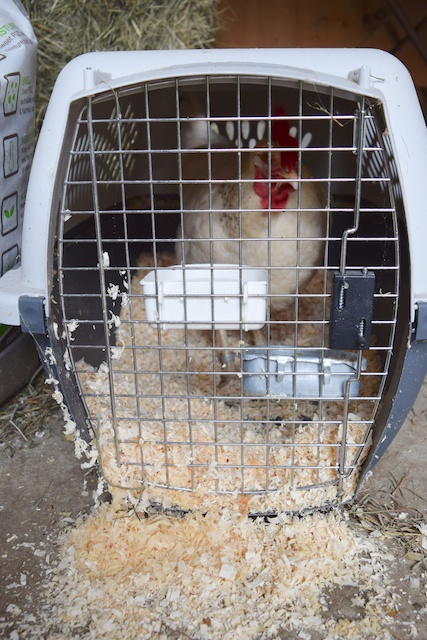
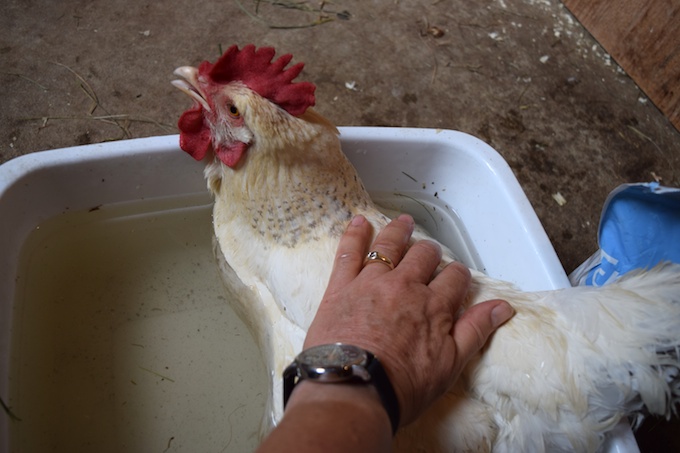
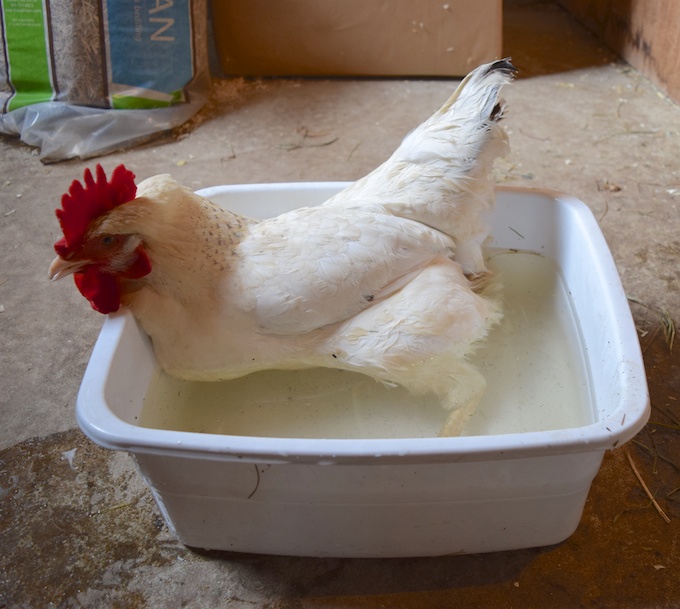
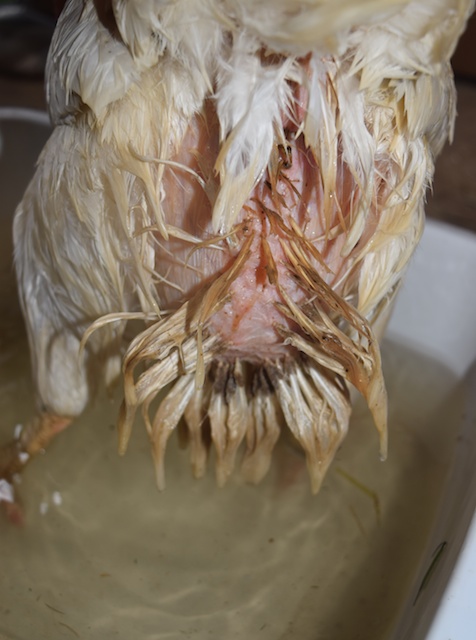

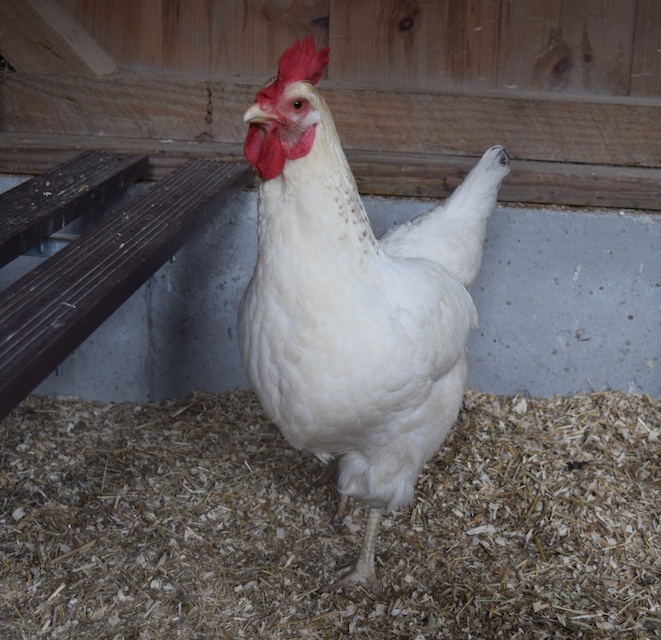

I am so glad that Opal appears to be on the mend!
Hi! So I’m far from town or any store and don’t have any Epsom salt, i was wondering if using a bath salt would also work? The bath salts i have are a mixture of oils and slats.
Epsom salt is unique. It would depend on whether your bath salt has epsom salts in the mix. It should say on the label. You can mail order epsom salts if necessary. Shipping will likely cost more than the product.
Again, a really good informative post. I must say I have used epsom salts on a couple of occasions (after having learnt to do so from your blogs). I have always found it marvellous and it is definitely a product to keep in the cupboard. My elderly hen was offf colour last week so I decided to bath her in epsom salts. As I put her in the bowl, I realised that she had sour crop (as I put her in all the fowl smelling fluid came out of her beak). I treated her with olive oil and yogurt and empltied her crop twice a day (and a dose of epsom salts). She has made a good recovery now thank goodness. I believe epsom salts is a “must have” product to keep in the house! Glad that Opal looks like she will be OK. Chicken keeping is a learning curve and it is wonderful to learn so many things from such a knowledgeable person as yourself – thank you.
Terrific that you solved the sour crop issue!
Louise…did you do the spa for sour crop or do they drink it…I have had several cases of this and it is the devil to cure.
I lost my Ohio Buckeye hen at the beginning of summer, she just got in the nest box and went to sleep, she showed no signs of illness or distress. .She was busy and eating in the morning and dead in the evening..I wasn’t brave enough to look inside of her before I buried her..so I don’t have a clue what happened. No other hens were having problems. Such is the life of hen keeping…but as a farm girl, from way back, I know that things happen….
That’s the right attitude.
As always, your posts are so informative and timely … I have a 3 year-old BSL hen that just stopped laying 3 days ago, after pumping them out every day for almost a month in a row. Yesterday evening she was just standing at the pop hole to the coop as if she wasn’t sure if she had the energy to go in. She did, after I went over to see if she was alright. I will give her an Epsom salts bath today, even though she seems herself again, the reason being that she has runny poop and a messy bottom. I figure that I can take the opportunity to check her out while she is soaking. I was wondering,can I give her the bath in the run with the rest of the gang, or is it better to do it in the storage are of the coop?
Do the bath wherever it’s convenient for you. In the winter I bring the hen into my mudroom. Opal got her bath in the barn. I think it’d be a tad chaotic to give the bath with the other hens coming over, though.
Thank you, Terry! You’re right about it being a tad chaotic in the the run with the others. I didn’t think that part through very well. :-) I will do it in my mudroom as per your suggestion, because it saves me hauling water from the house.
Yes great informative post. Such a pretty girl! I have a glw that is a very consistent layer but lays has a messy bottom. I did ready your post on vent gleet. She is 2 yrs 3 mos old and has been this way since a pullet. I am thinking she might do with. Epsom salt soak. I do classic ally ave to clean her bottom by running warm water on it. As sometimes it will look red and irritated. They do dust bath often. I love o watch this behavior.
Great post Terry..thank you!
Hi Terry I have a question after doing this spa treatment is it necessary to rinse the hen off with water?
Good question, easy answer. You don’t have to rinse. The epsom salt, unlike regular salt, is soothing to the skin.